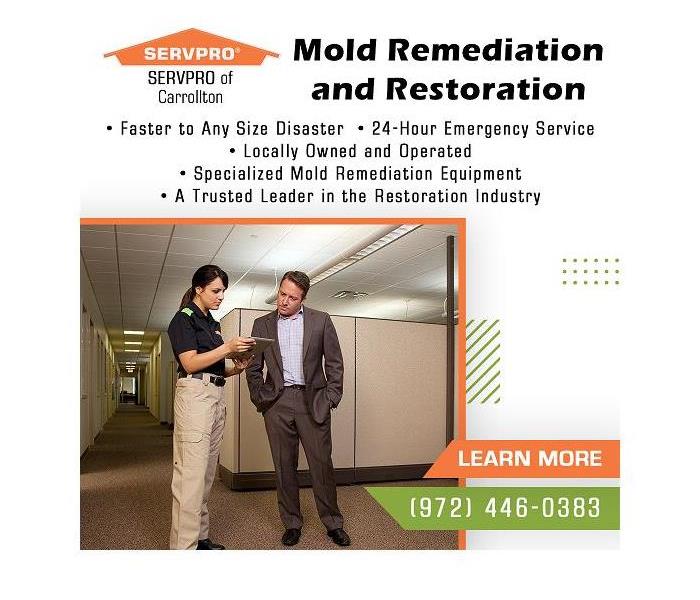Five Tips for Preventing Mold Growth During the Construction Process
3/24/2021 (Permalink)
Blog Summary: SERVPRO of Carrollton helps customers understand why industry certifications are vital for a property damage restoration company.
Led by a team with forty years of combined experience in the service industry, SERVPRO of Carrollton proudly serves the commercial damage restoration needs of local Carrollton and Bent Tree businesses. Years of experience dealing with mold infestations in commercial and residential settings enable the team to understand the devastation that unchecked mold growth can cause. It is especially important for builders, contractors, and other professionals in the construction industry to understand how mold growth during the construction process can put them at risk of litigation.
Buildings.com, an industry news source for building owners and facility managers, highlights the potential costs of a mold infestation resulting from construction defects. “Mold has always been present in our outdoor and indoor environments; it caused primarily minor concerns and problems until 2001 when a legal case in Texas awarded a homeowner $32 million as a result of mold infestation due to construction defects.”
While landlords are typically the target of litigations involving mold infestations, builders and contractors can be liable for a lawsuit in the following cases:
- A breach of contract: The construction process left the structure susceptible to mold growth.
- A breach of warranty: The construction work did not meet the standards required by state law or by a warranty, whether implied or expressly stated.
- Negligence: The builder failed to fulfill a duty to the plaintiff to keep the structure free of mold, and the plaintiff was harmed by the mold growth.
Preventing mold growth and minimizing opportunities for mold infestations during the construction process is essential in order to avoid future litigation by the client. No building company wants to find itself the defendant in a multi-million-dollar lawsuit over a mold infestation that could have been avoided by taking the right steps during the construction process. Fortunately, builders can implement several strategies that reduce the risk of mold infestation arising during the construction process.
- Prioritize building dry-in.
According to a leading environmental consulting firm, drying in is “the process of sealing the building envelope, which prevents the penetration of water into the interior. This includes installing a water-tight roof, exterior siding, windows, and seals around windows and other openings.”
- Keep all construction materials dry and well ventilated during the building process.
Moisture is a key ingredient for mold growth, so the proper watertight storage of construction materials is crucial to mold prevention. To reduce the storage time, it is recommended that the materials be delivered just before they are to be used.
If construction materials do become wet, let them dry sufficiently before they are used. Use a moisture meter to determine if the materials are dry enough to be used. Wood should not have more than 19% of moisture, while engineering materials should not have more than 4% of moisture.
- Consider using building materials specifically designed to resist moisture accumulation.
Moisture resistant building materials include:
- Paperless drywall
- Breathable wall insulation
- Non-porous flooring
- Decay-resistant wood, such as redwood, cedar, bald cypresses, and certain types of oaks
- Moisture-resistant gypsum board
- Waterproof mortar
- Ceramic tile
- Reinforced glass
- Brick and cement
- Steel
- Invest in commercial dehumidifying equipment.
Commercial dehumidifiers speed up the drying process for damp building materials and reduce the overall humidity and moisture within the structure that is being built. During particularly wet weather, a dehumidifier is an invaluable tool.
- Partner with a highly-qualified mold removal company to remediate any mold growth at a building.
If a mold infestation is detected or suspected during the construction process, the mold growth must be dealt with promptly and thoroughly in order to avoid litigation that could be financially devastating to the contractor. Even if no mold has been spotted, it may be a good idea to consult with a commercial mold removal company at the conclusion of the construction project to confirm that the structure is free of mold growth.
A trusted leader in the mold remediation industry, SERVPRO of Carrollton provides mold remediation services that instill confidence in both the construction contractor and the building owner. Technicians respond quickly and work to contain the infestation so that it does not spread throughout the structure. The team at SERVPRO of Carrollton has the education, experience, and equipment to safely and effectively implement the remediation process.
To learn more about the commercial damage restoration company, contact SERVPRO of Carrollton by email at office@SERVPRO10952.com. The office can also be reached by phone at (972) 446-0383.





 24/7 Emergency Service
24/7 Emergency Service
